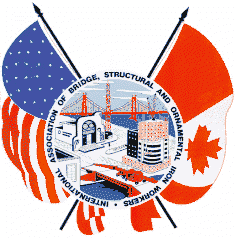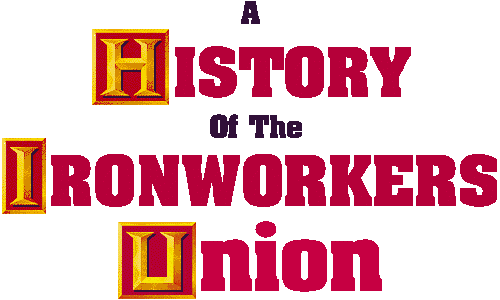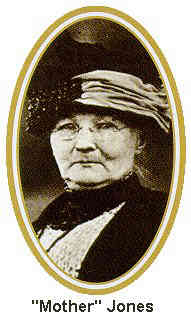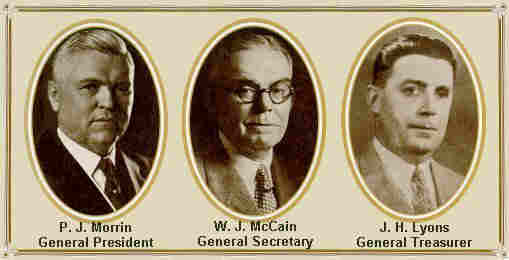|
|
|
|
Our History
A Union is Born
The Turbulent Years
The Conspiracy Trials
The Beginning of the
Morrin Era
The Depression and a New
Deal For Labor
World War II
Ironworkers Grow in the
1950's Part Two Part Three
John H. Lyons Jr.
Elected President
The Tradition Continues
Pathways to the 21st
Century Under The Leadership of General President Jake West
|
Part One
"MOTHER" JONES
"Mother" Jones' career traces nearly every page of the tough struggles of the American Labor movement. Ludlow, Colorado, Cabin Creek, West Virginia, the American Railway Union Strike, Homestead, all tragedies of the American working class, saw her in the fray. The great steel strike of 1919 was her last great venture, when she was one of a hundred organizers thrown into the fray against the steel trust. She was nominated to be one of "the twelve greatest women in the United States," and sponsored as one of the "six greatest women the world had ever known."
PASSAGE OF THE DAVIS-BACON ACT In the March, 1931 issue of the Bridgemen's Magazine the heading of the title page read, "Government Approves Prevailing Wage Rate." This was the Davis-Bacon Act that provided for the payment of prevailing wages to our members and all other workers employed by contractors or subcontractors on public construction. The conservative President Hoover signed this bill which continued to be supported by both Republican and Democratic presidents until 1995 when it would be under attack by conservative Republican members of Congress. President Morrin and the other members of the Executive Council of the Building Trades Department of the A. F. of L. conferred with President Hoover. They urged the President to maintain the present wage scales in the country against the attempts of management to decrease wages. They presented a letter stressing that the purchasing power of the public must not be impaired. William Green, President of the A. F. of L., also urged at this time that legislation be passed for the five-day week. Even William Randolph Hearst was proposing that with the demand and supply of manpower out of balance, American Industry should immediately consider ways and means of adjusting itself to the six-hour day. By October of 1931 the situation was becoming even worse with an estimated seven million unemployed. The Executive Council of the A. F. of L. urged that wage levels be maintained, that workers be given shorter hours, that jobs be created through public works, that employment agencies be set up, and that young people should be kept in school longer. An article in the Bridgemen's Magazine suggested that the unemployment situation among Ironworkers could be solved by building elevated highways over the railways in congested sections of major American Cities such as Detroit, Chicago, Buffalo and New York. A "National Elevated Toll Highway System" would be financed by the sale of bonds similar to those "Liberty Bonds" sold during World War I. In March of 1932, it was announced that the Iron Workers and forty-three other International Unions of the A. F. of L. along with the American Legion and other organizations had formed the "United Action for Employment Campaign." During this period of such mass unemployment the Carpenters Union announced they were breaking their agreement with the Ironworkers. This agreement regarding jurisdiction had been entered into back in January of 1920. The Carpenters announced that beginning July 1, 1931 the agreement was no longer in effect. By June of 1932 the Bridgemen's Magazine reported that the country's unemployment rate had reached eleven million. By this time thousands of homes across the country were being sold to cover unpaid taxes. William Green, A. F. of L. President, was concerned that many unions were planning to abandon regular Labor Day Parades, meeting, and addresses in 1932. Green felt such events must take place to help the public learn labor's story. At the same time, the Bridgemen's Magazine printed a story in July of 1932 about the wealth of one family alone...the Mellons. Their wealth of eight billion dollars was greater than all the money in the United States Treasury. (Andrew Mellon was the Secretary of the Treasury under Hoover. His prescription for curing the depression was "cut wages and lay off more workers." The Twenty-Fourth Convention of the Iron Workers was held September 19th to the 24th, in St. Louis, Missouri at the Jefferson Hotel. General President P. J. Morrin, General Secretary W. J. McCain and General Treasurer J. H. Lyons were reelected to office.
The delegates adopted a new Pension and disability plan at the Convention since the funds were almost depleted. The action of the convention was necessitated by the fact that our organization could no longer pay the pension benefits provided by the old law without financial disaster to the organization as a whole. In his report to the convention, President Morrin pointed out that the American Federation of Labor had decided that each trade should do the welding in connection with its own work, and that if the Ironworkers were going to keep pace with the times, it was up to the International to see that affiliate local unions were in a position to furnish capable and competent men that knew how to weld.
CONDITIONS IN CANADA FOR IRONWORKER LOCALS President Morrin in October of 1932 reported that the conditions for Canadian workers at this time were as difficult as those in the United States. The International Association exempted the members of the Canadian local unions, whose wage scale was less than $1.00 per hour, from paying the International $2.00 assessment. The non-union steel erecting firms in Canada had reduced the wages of Ironworkers, which the International and the Canadian local unions resisted in every way possible even to the extent of appealing to the Provincial Government officials against the unfair tactics of these non-union firms. These reductions necessarily affected the fair Canadian firms because they continued to pay the union scale of wages and, in doing this, placed themselves in a position to compete on a fair basis with non-union firms in securing work for the members of the Ironworkers.
Scroll to the top and click on
The Depression and a New Deal For
Labor - 1930 to 1940 - Part Two
[Home]
[Officers]
[Upcoming
Events] [Links
to Other Unions] |


 t
first the crash of 1929 had little impact on our Union because many
construction jobs were still in demand for ironworkers to complete
jobs. While Wall Street was referring to the collapse of the economy
as a "Wall Street Readjustment" many workers were seeing their
wages cut by as much as fifty percent, however, our members only had their
wages cut by 15.9 percent. The prediction of 1930 was that there
would be nine billion dollars worth of new construction with two billion
of this being in the public sector. However, by 1931, two years
after the crash, construction stopped and our membership dropped by fifty
percent. Only 14, 504 members remained in good standing.
t
first the crash of 1929 had little impact on our Union because many
construction jobs were still in demand for ironworkers to complete
jobs. While Wall Street was referring to the collapse of the economy
as a "Wall Street Readjustment" many workers were seeing their
wages cut by as much as fifty percent, however, our members only had their
wages cut by 15.9 percent. The prediction of 1930 was that there
would be nine billion dollars worth of new construction with two billion
of this being in the public sector. However, by 1931, two years
after the crash, construction stopped and our membership dropped by fifty
percent. Only 14, 504 members remained in good standing. On
November 30, 1930, famous labor crusader "Mother" Jones died at
the age of 100. She was a very close friend of the
Ironworkers. During her entire lifetime she was in the forefront of
labor struggles, cheering and inspiring men and women to fight for the
cause of organized labor. Her motherly interests were for the rights
of the coal miner, and her protest was against the abuses to which they
were subjected under the old company store system. Mine operators,
with this system placed in their hands, had complete control over the coal
miner's personal, family, educational and spiritual affairs.
She was also a member of the Knights of Labor. In 1891, at the age
of sixty-one, she participated in a mine strike where she save a miners
organizer and herself from the company gunmen who were going to kill
them. "Mother" Jones, using her Irish wit, convinced the
gunmen to let them go.
On
November 30, 1930, famous labor crusader "Mother" Jones died at
the age of 100. She was a very close friend of the
Ironworkers. During her entire lifetime she was in the forefront of
labor struggles, cheering and inspiring men and women to fight for the
cause of organized labor. Her motherly interests were for the rights
of the coal miner, and her protest was against the abuses to which they
were subjected under the old company store system. Mine operators,
with this system placed in their hands, had complete control over the coal
miner's personal, family, educational and spiritual affairs.
She was also a member of the Knights of Labor. In 1891, at the age
of sixty-one, she participated in a mine strike where she save a miners
organizer and herself from the company gunmen who were going to kill
them. "Mother" Jones, using her Irish wit, convinced the
gunmen to let them go.